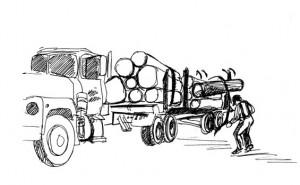BACKGROUND: A log truck driver was unbinding his load of double-bunked logs at a mill woodyard in the South. He was wearing a hard hat.
PERSONAL CHARACTERISTICS: The driver was experienced. He had been trained to inspect the load of logs prior to removing the binding straps.
UNSAFE ACT AND CONDITION: At the time of this accident, the mill did not have unbinding racks. The mill’s unloading policy was for trucks to wait in line for the yard crane to unload the trucks. When a truck was first or second in line, the driver was allowed to unbind his load. When this particular driver was near the head of the truck line, he exited his truck to unbind his load.
ACCIDENT: Before removing the straps, the driver inspected the load for loose or “danger” logs. Not seeing any, he proceeded to remove the straps. When he loosened one of the straps, a log rolled off the top of the load, struck him in the head, and knocked him to the ground. When he was on the ground, the same log struck his left hip.
INJURY: The driver suffered a dislocated hip but did not sustain a head injury.
RECOMMENDATIONS FOR CORRECTION:
- OSHA requires that “each tie-down shall be left in place over the peak log to secure all logs until the unloading line or other protection has been put in place.” Each woodyard must enforce this regulation.
- All woodyards should install unbinding racks or cages to protect log truck drivers from logs which might roll off log trailers when load binders are unbound.
- Logging contractors, loader operators, and log truck drivers must work together to ensure logs are not loaded above log trailer standards.
 Courtesy of the Forest Resources Association: https://www.forestresources.org/
Courtesy of the Forest Resources Association: https://www.forestresources.org/
